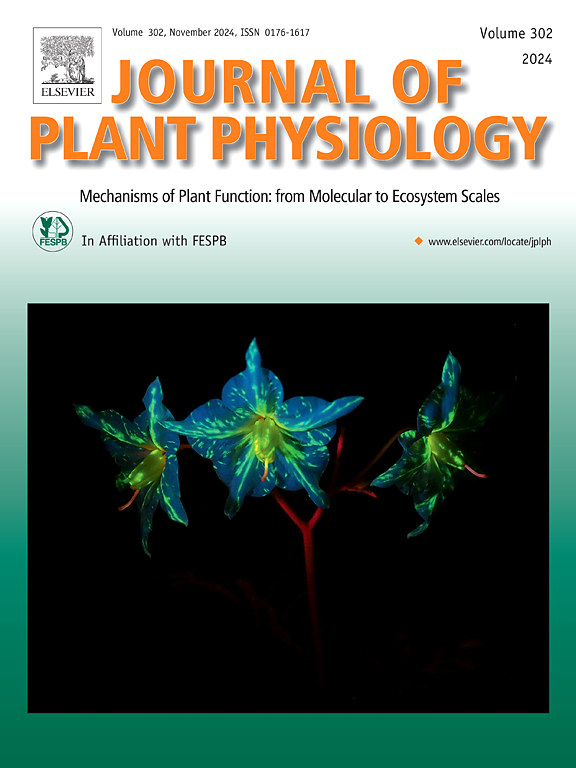The MeCNL3-MeARF6 module plays an important role in cassava bacterial blight resistance
IF 4.1
3区 生物学
Q1 PLANT SCIENCES
引用次数: 0
Abstract
Cassava bacterial blight (CBB) poses a substantial threat to the progression and sustainability of the cassava industry. While the NLR gene family is known to play a crucial role in plant disease resistance by encoding intracellular immune receptors, the specific molecular mechanisms underlying NLR-mediated resistance in cassava remain poorly understood and require comprehensive characterization. Our research identified MeCNL3, a CC-NBS-LRR resistance gene, demonstrating significant upregulation in response to Xanthomonas axonopodis pv. manihotis (Xam) infection. Functional characterization revealed that MeCNL3 overexpression confers enhanced resistance to Xam in cassava. Meanwhile, we demonstrated that MeCNL3 physically interacts with the transcription factor MeARF6, forming a regulatory module that controls Xam resistance. Notably, experimental evidence confirms that MeARF6 regulates MeRbohH transcription, orchestrating reactive oxygen species (ROS)-mediated defense responses against CBB. Furthermore, the type III effector protein XopR hijacks MeCNL3 to suppress the MeCNL3-MeARF6 signaling module, thereby weakening CBB resistance. Taken together, this work delineates the molecular mechanism of MeCNL3-driven CBB immunity and advances the understanding of NLR regulatory networks in cassava defense responses.
MeCNL3-MeARF6模块在木薯抗白叶枯病中起重要作用
木薯细菌性枯萎病(CBB)对木薯产业的发展和可持续发展构成了重大威胁。虽然已知NLR基因家族通过编码细胞内免疫受体在植物抗病性中起着至关重要的作用,但木薯NLR介导的抗性的具体分子机制仍然知之甚少,需要全面的表征。我们的研究发现了一种CC-NBS-LRR抗性基因MeCNL3,该基因在轴索黄单胞菌pv中表现出显著的上调。肛门炎(Xam)感染。功能表征显示,MeCNL3过表达增强了木薯对Xam的抗性。同时,我们证明了MeCNL3与转录因子MeARF6物理相互作用,形成一个控制Xam抗性的调控模块。值得注意的是,实验证据证实,MeARF6调节MeRbohH转录,协调活性氧(ROS)介导的针对CBB的防御反应。此外,III型效应蛋白XopR劫持MeCNL3,抑制MeCNL3- mearf6信号模块,从而减弱CBB耐药性。综上所述,这项工作描述了mecnl3驱动CBB免疫的分子机制,并推进了对木薯防御反应中NLR调控网络的理解。
本文章由计算机程序翻译,如有差异,请以英文原文为准。
求助全文
约1分钟内获得全文
求助全文
来源期刊

Journal of plant physiology
生物-植物科学
CiteScore
7.20
自引率
4.70%
发文量
196
审稿时长
32 days
期刊介绍:
The Journal of Plant Physiology is a broad-spectrum journal that welcomes high-quality submissions in all major areas of plant physiology, including plant biochemistry, functional biotechnology, computational and synthetic plant biology, growth and development, photosynthesis and respiration, transport and translocation, plant-microbe interactions, biotic and abiotic stress. Studies are welcome at all levels of integration ranging from molecules and cells to organisms and their environments and are expected to use state-of-the-art methodologies. Pure gene expression studies are not within the focus of our journal. To be considered for publication, papers must significantly contribute to the mechanistic understanding of physiological processes, and not be merely descriptive, or confirmatory of previous results. We encourage the submission of papers that explore the physiology of non-model as well as accepted model species and those that bridge basic and applied research. For instance, studies on agricultural plants that show new physiological mechanisms to improve agricultural efficiency are welcome. Studies performed under uncontrolled situations (e.g. field conditions) not providing mechanistic insight will not be considered for publication.
The Journal of Plant Physiology publishes several types of articles: Original Research Articles, Reviews, Perspectives Articles, and Short Communications. Reviews and Perspectives will be solicited by the Editors; unsolicited reviews are also welcome but only from authors with a strong track record in the field of the review. Original research papers comprise the majority of published contributions.
 求助内容:
求助内容: 应助结果提醒方式:
应助结果提醒方式:


